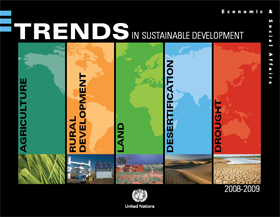Trends in Sustainable Development Reports
 Trends in Sustainable Development
Trends in Sustainable Development
:: 2008-2009
Efforts to reduce poverty and improve food security in developing countries are hampered by declining support for strong agricultural growth, long considered a hallmark of successful poverty reduction strategies, according to the 2008 Trends in Sustainable Development report [pdf 3.7 MB] published by the Department of Economic and Social Affairs.
The report highlights recent trends in agriculture, rural development, land, desertification and drought – five of the six themes being considered by the Commission on Sustainable Development at its 16th and 17th sessions (2008-2009).
Strong agricultural growth is four times more effective than growth in other sectors in benefiting the poorest half of the population, the report finds. However, while many developing countries have posted gains in agricultural production, distribution and exports, people living in areas of high inequality and in isolation from the broader economy typically benefit little from them.
A Snapshot of Trends:
- Public spending on agriculture has fallen in all regions except Asia over the past generation, with the drop in Latin America the most dramatic.
- Foreign assistance for agriculture is at low levels. In real terms, agriculture accounted for just 4 per cent of bilateral assistance in 2003, down from 16 per cent in 1980.
- More regions have become net food importers since the mid-1990s, including East Asia, Oceania and sub-Saharan Africa.
- Markets for value-added exports from developing countries are limited by high tariffs and low brand recognition in developed countries. Many developing country producers are unable to meet strict standards in developed nations.
- Developing regions are likely to stay mostly rural until 2020. South and Central Asia, and sub-Saharan Africa will remain more than 50 per cent rural until 2030.
- Non-farm income represents an increasingly important share of rural income in developing countries.
- “No roads, no economic opportunities”, particularly in sub-Saharan Africa.
- Two billion people live in drylands, areas that have the world’s lowest per capita GDP and highest infant mortality rates. These populations are especially vulnerable to further land degradation.
- Droughts can be predictable, making it possible to respond with regional early warning systems. In Africa, droughts tend to result in high mortality rates, particularly in the sub-Saharan region, due to the low level of preparedness. In some developing countries, drought wiped out more than 5 per cent of the previous year’s GDP.
Download Full Report
- Trends in Sustainable Development Report 2008-2009 [pdf 3.7 MB]


 Introduction
Introduction Agriculture
Agriculture Rural development
Rural development Land
Land Desertification
Desertification Drought
Drought